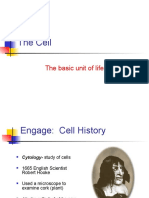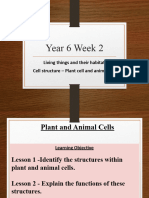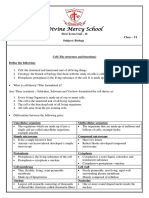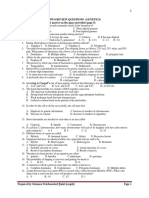0 ratings0% found this document useful (0 votes)
155 viewsLesson 1 Worksheet
The document compares and contrasts prokaryotic and eukaryotic cells. It instructs students to complete a Venn diagram comparing the characteristics and structures of prokaryotic and eukaryotic cells. Key differences include that prokaryotic cells are smaller, lack organelles and a nucleus, while eukaryotic cells are larger, have membrane-bound organelles and a nucleus. It also briefly defines what qualifies something as living, noting traits like being made of cells, ability to grow and reproduce, and response to surroundings. Cells are then defined as the basic structural and functional units of living things.
Uploaded by
Joon Bok NamleeCopyright
© © All Rights Reserved
Available Formats
Download as DOCX, PDF, TXT or read online on Scribd
0 ratings0% found this document useful (0 votes)
155 viewsLesson 1 Worksheet
The document compares and contrasts prokaryotic and eukaryotic cells. It instructs students to complete a Venn diagram comparing the characteristics and structures of prokaryotic and eukaryotic cells. Key differences include that prokaryotic cells are smaller, lack organelles and a nucleus, while eukaryotic cells are larger, have membrane-bound organelles and a nucleus. It also briefly defines what qualifies something as living, noting traits like being made of cells, ability to grow and reproduce, and response to surroundings. Cells are then defined as the basic structural and functional units of living things.
Uploaded by
Joon Bok NamleeCopyright
© © All Rights Reserved
Available Formats
Download as DOCX, PDF, TXT or read online on Scribd
You are on page 1/ 2
Lesson 1: Cell theory, Prokaryotic and Eukaryotic Cell
Activity 1: Venn diagram
Direction: Compare and Contrast the figure you see below according to their
characteristics and structure. Record your observations in the Venn diagram.
Prokaryote cell Eukaryote cell
Simple structure Complex structure
No nucleus With nucleus
Contains
Small in size Large in size
cytoplasm
No organelles Membrane bounded
Has Ribosomes
Has flagellum, organelles;
Plasma
pilus & cell wall Has lysosome,
membrane
Mitochondria,
Contains DNA
Endoplasmic reticulum
& Golgi apparatus
Activity 2: Briefly answer the question/s below.
1. How do you know if something is alive?
To determine whether or whether something is alive. We must seek for several traits
or functions that all living beings share: first, they must be made up of cells, able to
move, utilize energy and obtain energy from a source, grow and develop, reproduce,
and last, they must respond and adapt to their surroundings.
2. How do you define Cell?
All living things are made up of cells, which are the structural, functional, and biological
components. Cells are made up of several sections, each of which serves a different
purpose. Organelles, for example, are specialized structures that perform specific jobs
within the cell.
______________________________________________________________________
“Do not conform to the pattern of this world, but be transformed by the renewing of your
mind. Then you will be able to test and approved what God’s will is – his good, pleasing
and perfect will. “
Romans 12:2
______________________________________________________________________
Happy Birthday Carlo!! Hooray
You might also like
- SHS STEM Bio1 Q1 Week 1 Module 2 - Cell Structure And-Functions67% (3)SHS STEM Bio1 Q1 Week 1 Module 2 - Cell Structure And-Functions23 pages
- Kami Export - Aubrianna Labonte-Postell - CellStructure GizmoNo ratings yetKami Export - Aubrianna Labonte-Postell - CellStructure Gizmo5 pages
- Cell Structure: Structural Functional Unit: Unit100% (1)Cell Structure: Structural Functional Unit: Unit13 pages
- SHS STEM Bio1 Q1 Week 1 Module 2 Cell Structure and Functions 150% (4)SHS STEM Bio1 Q1 Week 1 Module 2 Cell Structure and Functions 117 pages
- Review: Cell Structures and Functions: Stem 12 General Biology 1No ratings yetReview: Cell Structures and Functions: Stem 12 General Biology 1114 pages
- Chapter 1 - Cell Structure and OrganellesNo ratings yetChapter 1 - Cell Structure and Organelles48 pages
- Learning Packet in Level 1-Anatomy and Physiology: College of Nursing School Year 2021-2022No ratings yetLearning Packet in Level 1-Anatomy and Physiology: College of Nursing School Year 2021-202218 pages
- Structure and Functions of The Plant and Animal CellNo ratings yetStructure and Functions of The Plant and Animal Cell7 pages
- The Frankfurt School and The Culture IndustryNo ratings yetThe Frankfurt School and The Culture Industry4 pages
- Constructivist Theory (Jerome Bruner) : The Zone of Proximal Development (ZPD) Has Been Defined AsNo ratings yetConstructivist Theory (Jerome Bruner) : The Zone of Proximal Development (ZPD) Has Been Defined As2 pages
- What I Learned in The Course Readings in The Philippine HistoryNo ratings yetWhat I Learned in The Course Readings in The Philippine History2 pages
- The Big Bang Theory Is The Leading Explanation About How The Universe BeganNo ratings yetThe Big Bang Theory Is The Leading Explanation About How The Universe Began31 pages
- Key Dimensions of Inclusive Education in The Basic Education100% (1)Key Dimensions of Inclusive Education in The Basic Education1 page
- Separation of Sulfur, Salt, Iton Fillings and SandNo ratings yetSeparation of Sulfur, Salt, Iton Fillings and Sand3 pages
- Education Response To The Needs of The Society and CommunityNo ratings yetEducation Response To The Needs of The Society and Community2 pages
- A. Personal Background of The Psychologists or Advocates in Education (Please Include Picture/s)No ratings yetA. Personal Background of The Psychologists or Advocates in Education (Please Include Picture/s)3 pages
- The Emphasis in Learning Should Be On The Development of Meaning and ComprehensionNo ratings yetThe Emphasis in Learning Should Be On The Development of Meaning and Comprehension1 page
- This Topic. So Congratulations Because Today I'm Going To Talk About TheNo ratings yetThis Topic. So Congratulations Because Today I'm Going To Talk About The3 pages
- Colligative Property Freezing Point DepressionNo ratings yetColligative Property Freezing Point Depression4 pages
- Problem:: Mass of Solute Mass of Solution X 100No ratings yetProblem:: Mass of Solute Mass of Solution X 1003 pages
- General Biology 2: Department of EducationNo ratings yetGeneral Biology 2: Department of Education3 pages
- Extra DPP-01 - Molecular Basis of InheritanceNo ratings yetExtra DPP-01 - Molecular Basis of Inheritance7 pages
- An Introduction To Child and Adolescent Development (Erik Erikson) Slides 1-12No ratings yetAn Introduction To Child and Adolescent Development (Erik Erikson) Slides 1-1212 pages
- Genei Dna Fingerprinting Teaching Kit ManualNo ratings yetGenei Dna Fingerprinting Teaching Kit Manual10 pages
- ELS Benefits of Genetically Modified OrganismsNo ratings yetELS Benefits of Genetically Modified Organisms17 pages
- AI Course Project - Timetable SchedulingNo ratings yetAI Course Project - Timetable Scheduling5 pages
- Reproduction in Animals: Ultiple Hoice UestionsNo ratings yetReproduction in Animals: Ultiple Hoice Uestions6 pages
- Review Questions Unit Two (Without Answer)No ratings yetReview Questions Unit Two (Without Answer)8 pages
- Cell Cycle and Cell Division - DPP 01 - Yakeen NEET 2.0 202No ratings yetCell Cycle and Cell Division - DPP 01 - Yakeen NEET 2.0 2024 pages
- Chapter 5 - The Biological Foundations of PersonalityNo ratings yetChapter 5 - The Biological Foundations of Personality7 pages
- Study On The Appearance of Aquiline Noses in The Population of Covenant UniversityNo ratings yetStudy On The Appearance of Aquiline Noses in The Population of Covenant University8 pages
- 1 Metagenomics Principles and Applications PPinto100% (1)1 Metagenomics Principles and Applications PPinto44 pages
- Thompson Thompson Genetics in Medicine Robert L. Nussbaum - The ebook is available for instant download, read anywhere100% (1)Thompson Thompson Genetics in Medicine Robert L. Nussbaum - The ebook is available for instant download, read anywhere57 pages
- B5773f4ffa6afa04fd903699cf8 15c491ba 1718C5No ratings yetB5773f4ffa6afa04fd903699cf8 15c491ba 1718C529 pages
- Animal Biotechnology Models in Discovery and Translation 2nd 2nd Edition Ashish S. Verma All Chapter Instant Download100% (10)Animal Biotechnology Models in Discovery and Translation 2nd 2nd Edition Ashish S. Verma All Chapter Instant Download84 pages
- Adaptationism and Optimality 1st Edition Steven Hecht OrzackNo ratings yetAdaptationism and Optimality 1st Edition Steven Hecht Orzack84 pages













































































































